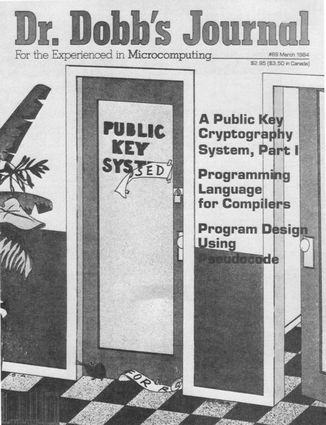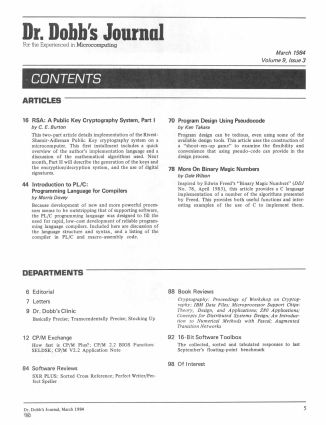
#Edito
TABLE OF CONTENTS
[author : C. E. Burton]
This two-part article details implementation of the Rivest- Shamir-Adleman Public Key cryptography system on a microcomputer. This first installment includes a quick overview of the author's implementation language and a discussion of the mathematical algorithms used. Next month, Part II will describe the generation of the keys and the encryption/decryption system, and the use of digital signatures.
[author : Morris Dovey]
Because development of new and more powerful processors seems to be outstripping that of supporting software, the PL/C programming language was designed to fill the need for rapid, low-cost development of reliable programming language compilers. Included here are discussion of the language structure and syntax, and a listing of the compiler in PL/C and macro-assembly code.
[author : Ken Takara]
Program design can be tedious, even using some of the available design tools. This article uses the construction of a "shoot-em-up game" to examine the flexibility and convenience that using pseudo-code can provide in the design process.
[author : Dale Wilson]
Inspired by Edwin Freed's "Binary Magic Numbers" (DDJ No. 78, April 1983), this article provides a C language implementation of a number of the algorithms presented by Freed. This provides both useful functions and interesting examples of the use of C to implement them.
Basically Precise; Transcendentally Precise; Stocking Up
How fast is CP/M Plus?; CP/M 2.2 BIOS Function: SELDSK; CP/M V2.2 Application Note
SXR PLUS: Sorted Cross Reference; Perfect Writer/Perfect Speller
Cryptography: Proceedings of Workshop on Cryptography; IBM Data Files; Microprocessor Support Chips: Theory, Design, and Applications ; Z80 Applications; Concepts for Distributed Systems Design; An Introduction to Numerical Methods with Pascal; Augmented Transition Networks
The collected, sorted and tabulated responses to last September's floating-point benchmark
